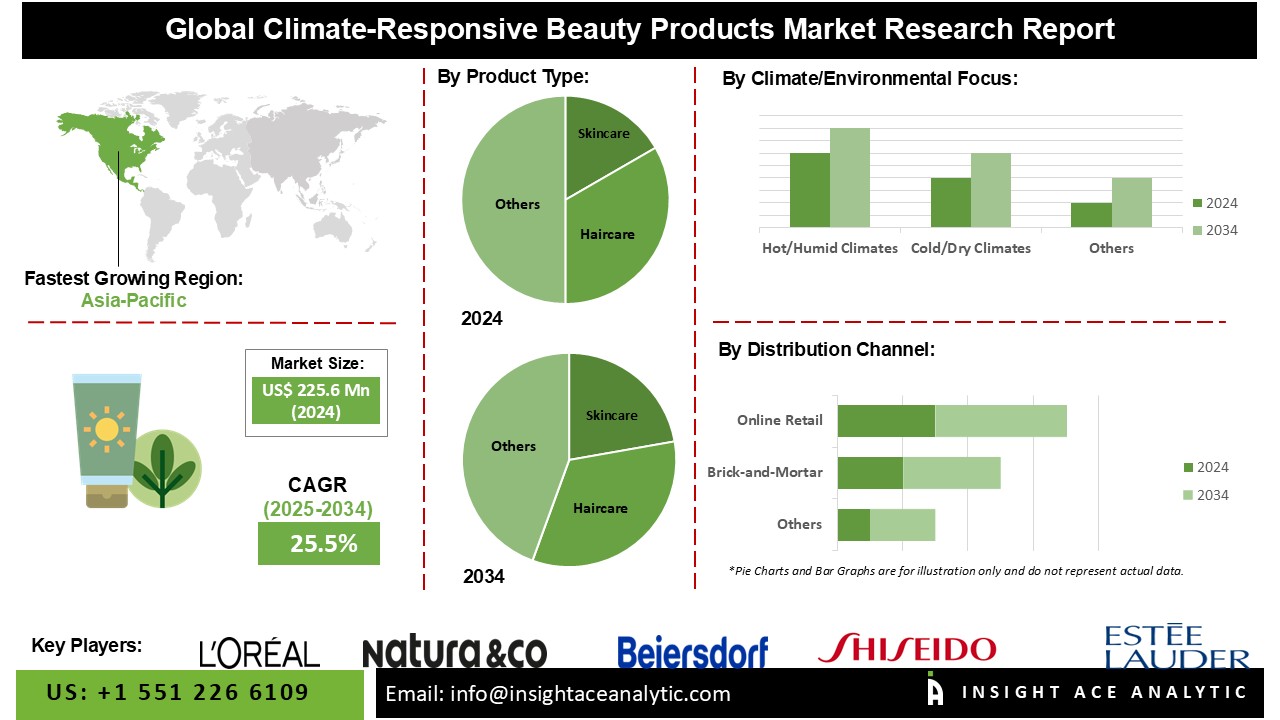The Climate-Responsive Beauty Products Market Size is valued at USD 225.6 Million in 2024 and is predicted to reach USD 2,138.5 Million by the year 2034 at a 25.5% CAGR during the forecast period for 2025-2034.

Climate-responsive beauty products, also known as climate-adaptive or geo-skincare, are a specialized class of skincare and cosmetic formulations developed to address the effects of changing environmental conditions on the skin. These products go beyond traditional formulations by considering factors such as temperature fluctuations, humidity, pollution, and increased UV radiation many of which are intensified by climate change. Designed to help the skin adapt to various climates, they work to maintain hydration, balance, and protection regardless of the environment.
Some advanced formulations are even capable of sensing and responding to changes in humidity levels. To achieve optimal hydration across different climates, these products may use lightweight ingredients like hyaluronic acid for humid conditions and richer, emollient components like shea butter and ceramides for drier settings. Additionally, ingredients such as ceramides, peptides, and fatty acids help reinforce the skin's natural barrier, enhancing its resilience against harsh weather and environmental stressors. As rising global temperatures, increased UV radiation, air pollution, and extreme weather increasingly impact skin and hair health, consumers are seeking beauty solutions that protect against environmental stressors and adapt to diverse climate conditions.
The demand for personalized skincare routines that respond to real-time factors like location, weather, and skin state is growing rapidly. Smart beauty brands are leveraging AI and diagnostic technologies to offer climate-specific product recommendations, meeting the needs of global travelers and urban dwellers who face rapidly changing environments. Simultaneously, advances in adaptive ingredients, thermo-responsive systems, and environment-sensing formulations are revolutionizing product development, enabling skincare and haircare that evolves alongside environmental shifts.
The climate-responsive beauty products market is segmented based on product type, climate/environmental focus, distribution channel, and ingredients. Based on Product Type, the market is segmented into skincare, haircare, makeup. Based on climate/environmental focus, the market is divided into hot/humid climates, cold/dry climates, polluted urban areas, high UV exposure, and seasonal adaptability. Based on the distribution channel, the market is divided into online retail, brick-and-mortar, direct sales, and health and wellness retailers. Based on the ingredients, the market is divided into UV-protective ingredients, hydration and barrier-protective ingredients, anti-pollution and antioxidant ingredient, smart and adaptive ingredients.
Based on Product Type, the market is segmented into skincare, haircare, makeup, and personal care. Among these, the skincare segment is expected to have the highest growth rate during the forecast period. Skin is the most visibly and immediately affected by environmental stressors such as UV radiation, pollution, temperature fluctuations, and humidity.
As a result, consumers are increasingly investing in products that protect, repair, and help the skin adapt to changing climatic conditions. The rising awareness of issues like premature aging, sun damage, and the importance of maintaining a healthy skin barrier has further driven demand for climate-adaptive skincare solutions, including moisturizers, sunscreens, serums, and creams. Consequently, a significant portion of climate-responsive research and innovation is currently centered around skincare, with advancements in smart moisturizers, adaptive SPF, and hydration-balancing serums leading the way.
The Asia-Pacific region spans a wide range of climates including tropical, humid, dry, and high-UV environments creating strong demand for climate-specific skincare, haircare, and cosmetics. Rapid urban growth across the region has intensified exposure to pollution and environmental stressors, further accelerating the need for protective and adaptive beauty solutions. Additionally, countries such as China, India, Indonesia, and Japan represent some of the world’s largest and most dynamic consumer markets for beauty products, making Asia-Pacific a key driver in the growth of the climate-responsive beauty products market.
| Report Attribute | Specifications |
| Market Size Value In 2024 | USD 225.6 Mn |
| Revenue Forecast In 2034 | USD 2,138.5 Mn |
| Growth Rate CAGR | CAGR of 25.5% from 2025 to 2034 |
| Quantitative Units | Representation of revenue in US$ Mn,and CAGR from 2025 to 2034 |
| Historic Year | 2021 to 2024 |
| Forecast Year | 2025-2034 |
| Report Coverage | The forecast of revenue, the position of the company, the competitive market structure, growth prospects, and trends |
| Segments Covered | By Product Type, Climate/Environmental Focus, Distribution Channel, Ingredient |
| Regional Scope | North America; Europe; Asia Pacific; Latin America; Middle East & Africa |
| Country Scope | U.S.; Canada; U.K.; Germany; China; India; Japan; Brazil; Mexico; France; Italy; Spain; South East Asia; South Korea |
| Competitive Landscape | Shiseido Company, Limited, Fenty Beauty, Pour Moi Skincare, Croda International Plc, Atmosphera, Seppic, Prada, lilixir, Ogee, BASF |
| Customization Scope | Free customization report with the procurement of the report and modifications to the regional and segment scope. Particular Geographic competitive landscape. |
| Pricing And Available Payment Methods | Explore pricing alternatives that are customized to your particular study requirements. |
Global Climate-Responsive Beauty Products Market - By Product Type
Global Climate-Responsive Beauty Products Market – By Climate/Environmental Focus
Global Climate-Responsive Beauty Products Market – By Distribution Channel
Global Climate-Responsive Beauty Products Market – By Ingredient
Global Climate-Responsive Beauty Products Market – By Region
North America-
• The US
• Canada
Europe-
• Germany
• The UK
• France
• Italy
• Spain
• Rest of Europe
Asia-Pacific-
• China
• Japan
• India
• South Korea
• Southeast Asia
• Rest of Asia Pacific
Latin America-
• Brazil
• Argentina
• Mexico
• Rest of Latin America
Middle East & Africa-
• GCC Countries
• South Africa
• Rest of the Middle East and Africa